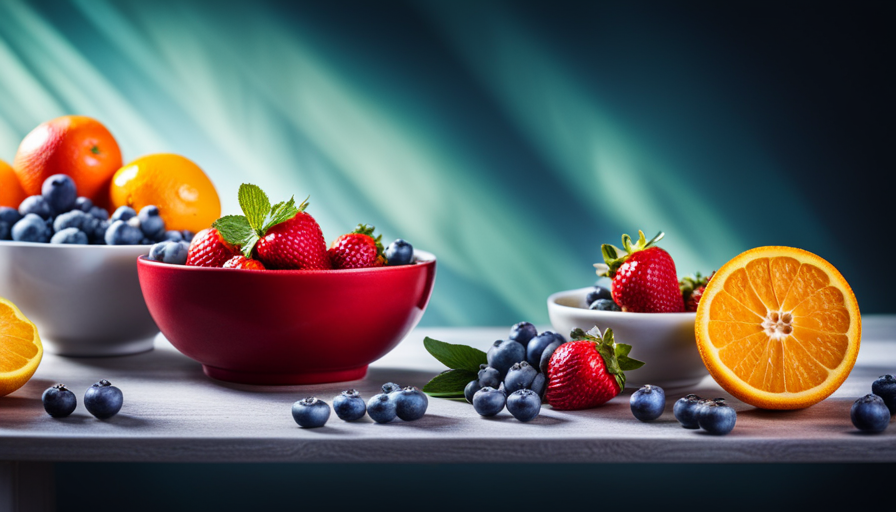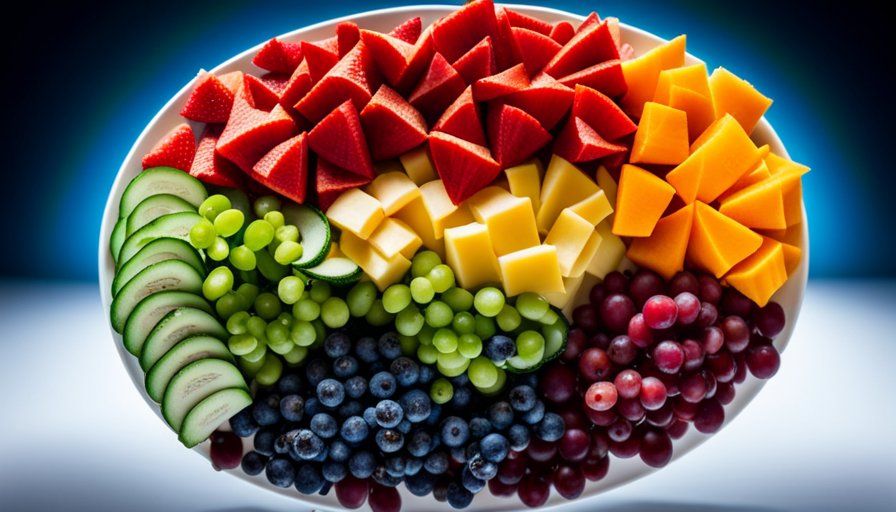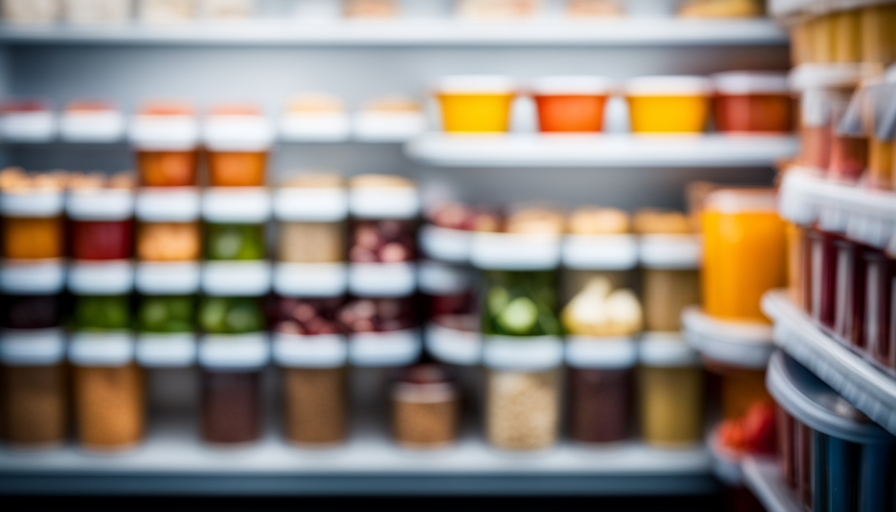Do you have dark circles under your eyes that remind you of sleepless nights and stressful days? Don’t let them overshadow your natural beauty any longer! Picture a glowing, rejuvenated face that exudes confidence. It’s time to unlock the benefits of raw food to get rid of those stubborn dark circles once and for all.
Dark circles can be caused by a variety of factors, including genetics, lack of sleep, and poor nutrition. But fear not! By incorporating raw fruits and vegetables into your diet, you can nourish your skin from within and unveil a brighter, more vibrant complexion.
In this article, we will explore the importance of a healthy diet for skin health, as well as the benefits of juicing and DIY raw food face masks. We will also delve into the essential nutrients and superfoods that can help reduce dark circles.
By making simple lifestyle changes and maintaining a consistent raw food routine, you can finally bid farewell to those stubborn dark circles and embrace the radiant glow you deserve.
Get ready to transform your under-eye area and let your true beauty shine!
Key Takeaways
- Incorporating raw fruits and vegetables into the diet can nourish the skin from within and improve complexion.
- Juicing can provide a powerful dose of vitamins, minerals, and antioxidants for clearer skin.
- DIY raw food face masks can improve the health and appearance of the skin.
- Staying hydrated and maintaining a balanced diet rich in fruits and vegetables can reduce dark circles.
Understanding the Causes of Dark Circles
Let’s dive into the fascinating world of dark circles and understand what causes them.
Dark circles, also known as periorbital hyperpigmentation, are the discolored areas around the eyes. There are several factors that contribute to the development of dark circles.
One of the main causes is the thinning of the skin around the eyes, which makes the blood vessels underneath more visible. This can be genetic or age-related.
Lack of sleep and fatigue can also lead to dark circles as they cause the blood vessels to dilate, resulting in a bluish tint.
Allergies and nasal congestion can cause the blood vessels around the eyes to become inflamed, leading to dark circles.
Another common cause is sun exposure, as it prompts the production of melanin, the pigment responsible for skin color.
Lastly, poor nutrition and dehydration can contribute to the appearance of dark circles.
To combat dark circles, it is important to address the underlying causes. Remedies for dark circles include getting enough sleep, managing allergies and congestion, protecting your skin from the sun, and maintaining a healthy diet and hydration level.
Importance of a Healthy Diet for Skin Health
Maintaining a healthy diet rich in nutrient-dense ingredients ensures your skin receives the nourishment it needs to radiate a youthful glow.
Your skin is the largest organ in your body and requires proper care to stay healthy. By incorporating a variety of fruits and vegetables into your diet, you can provide your skin with essential antioxidants that help combat the damage caused by free radicals. Antioxidants, such as vitamins C and E, neutralize these harmful molecules, reducing inflammation and promoting a more even skin tone.
Hydration also plays a crucial role in maintaining healthy skin. Drinking an adequate amount of water throughout the day helps to keep your skin hydrated and plump, reducing the appearance of fine lines and wrinkles. Additionally, staying hydrated supports the natural detoxification process of your body, flushing out toxins that can contribute to skin issues like acne and dullness.
To ensure your diet is skin-friendly, consider incorporating the following nutrient-rich foods:
-
Berries: Blueberries, strawberries, and raspberries are packed with antioxidants that protect your skin from damage.
-
Leafy greens: Spinach, kale, and Swiss chard are excellent sources of vitamins A and C, which promote collagen production and support skin elasticity.
-
Nuts and seeds: Almonds, walnuts, and flaxseeds provide essential fatty acids that help maintain the skin’s moisture barrier.
-
Citrus fruits: Oranges, lemons, and grapefruits are high in vitamin C, which aids in collagen synthesis and brightens the skin.
-
Avocado: This creamy fruit is rich in healthy fats and vitamin E, promoting skin hydration and reducing inflammation.
By incorporating these foods into your diet, you can support your skin’s health from the inside out and improve the appearance of dark circles. Remember to stay hydrated and enjoy a colorful variety of nutrient-dense foods to nourish your skin and reveal a radiant complexion.
Incorporating Raw Fruits and Vegetables into Your Meals
Enhance your culinary creations by infusing them with the vibrant and refreshing essence of nature’s bounty – raw fruits and vegetables! Incorporating raw fruits and vegetables into your meals not only adds a burst of flavor and texture but also provides numerous health benefits.
Raw food recipes are an excellent way to incorporate these nutritious ingredients into your diet. One of the key benefits of raw food is that it retains more nutrients compared to cooked food. Heat can destroy certain vitamins, minerals, and enzymes present in fruits and vegetables. By consuming them raw, you ensure that you’re getting the maximum nutritional value from these foods.
Raw fruits and vegetables are also rich in antioxidants, which help protect your body from oxidative stress and reduce the risk of chronic diseases. They’re also high in fiber, which aids in digestion and helps maintain a healthy weight.
Incorporating raw foods into your meals can be as simple as adding a handful of fresh berries to your morning cereal or blending a variety of raw vegetables into a delicious smoothie. You can also experiment with raw food recipes like colorful salads, zucchini noodles, or raw vegan desserts.
By incorporating raw fruits and vegetables into your meals, you can enjoy their vibrant flavors and reap the numerous health benefits they offer. So why not give it a try and savor the goodness of nature’s bounty in every bite?
Juicing for Clearer Skin
Experience the natural radiance of your skin by incorporating juicing into your daily routine – it’s a delicious and refreshing way to achieve a healthy glow!
Juicing isn’t just a trendy health fad, but it can also work wonders for your skin. By extracting the nutrients from fresh fruits and vegetables, you can give your skin a powerful dose of vitamins, minerals, and antioxidants that promote clearer skin.
Certain fruits and vegetables are especially beneficial for improving your skin’s appearance. For example, carrots are rich in beta-carotene, which can help repair and rejuvenate damaged skin cells. And leafy greens like spinach and kale are packed with vitamins A and C, which are essential for collagen production and skin elasticity.
To enhance the effects of juicing on your skin, consider adding facial massages to your skincare routine. Gently massaging your face while applying the freshly juiced mixture can help stimulate blood circulation, promote lymphatic drainage, and increase the absorption of nutrients into your skin.
While juicing can be a great addition to your skincare routine, it’s important to remember that it’s not a magical cure-all. It works best when combined with a healthy lifestyle, including proper hydration, a balanced diet, regular exercise, and good sleep habits.
Juicing can be a fantastic natural remedy for achieving clearer skin. By incorporating nutrient-rich fruits and vegetables into your daily routine and complementing it with facial massages, you can experience the natural radiance and healthy glow you’ve always desired.
DIY Raw Food Face Masks
Transform your skincare routine with DIY face masks made from fresh, nourishing ingredients that will leave your skin glowing and rejuvenated. Raw food beauty benefits are well-known for their ability to improve the health and appearance of your skin. By using raw food ingredients in your face masks, you can harness the power of natural enzymes, vitamins, and antioxidants to promote clearer and more radiant skin.
Here are three raw food recipes for glowing skin that you can easily make at home:
| Face Mask | Ingredients | Benefits |
|---|---|---|
| Avocado and Honey Mask | 1 ripe avocado, 1 tablespoon raw honey | The healthy fats in avocado moisturize and nourish the skin, while honey has antibacterial properties that help fight acne. |
| Strawberry and Yogurt Mask | 4-5 ripe strawberries, 2 tablespoons plain yogurt | Strawberries are rich in vitamin C, which brightens the complexion and evens out skin tone. Yogurt contains lactic acid, which gently exfoliates and tightens pores. |
| Cucumber and Aloe Vera Mask | ½ cucumber, 2 tablespoons fresh aloe vera gel | Cucumber soothes and hydrates the skin, reducing puffiness and inflammation. Aloe vera is known for its healing properties and can help fade dark circles. |
By incorporating these raw food face masks into your skincare routine, you can achieve a natural, healthy glow and improve the appearance of dark circles. Give them a try and see the transformative power of raw food on your skin.
Hydration and its Impact on Dark Circles
Now that you’re familiar with DIY Raw Food Face Masks, let’s delve into the importance of hydration and its impact on dark circles.
Dark circles under the eyes can be caused by a variety of factors, including dehydration. When your body is lacking proper hydration, it can lead to dull and dry skin, making dark circles more prominent. That’s why incorporating hydration tips into your skincare rituals is crucial for combating dark circles.
First and foremost, make sure you’re drinking an adequate amount of water throughout the day. Aim for at least eight glasses, or about two liters, to keep your body hydrated from within. Additionally, include hydrating foods in your raw food diet, such as cucumbers, watermelon, and leafy greens, as they contain high water content.
Another effective way to hydrate your skin and reduce dark circles is by using topical products that lock in moisture. Look for eye creams or serums that contain hydrating ingredients like hyaluronic acid or aloe vera. These products can help plump and moisturize the delicate skin under your eyes, reducing the appearance of dark circles.
Remember, maintaining proper hydration is not only essential for overall health but also plays a significant role in achieving a brighter and more youthful complexion. So, don’t forget to prioritize hydration in your skincare routine for a fresh and rejuvenated look.
Essential Nutrients for Skin Brightening
To achieve a brighter and more youthful complexion, it’s crucial to understand the importance of essential nutrients for skin brightening. The right combination of natural remedies and dietary supplements can work wonders in reducing dark circles.
Here are three essential nutrients that can help you achieve that coveted glow:
-
Vitamin C: This powerful antioxidant not only boosts collagen production, but it also helps fade dark spots and pigmentation. Include fruits like oranges, strawberries, and kiwis in your diet, or consider taking a vitamin C supplement.
-
Vitamin K: Known for its ability to improve blood circulation, vitamin K can reduce the appearance of dark circles. Leafy green vegetables like spinach, kale, and broccoli are excellent dietary sources of this nutrient.
-
Omega-3 fatty acids: These healthy fats are essential for maintaining skin health. They help strengthen the skin’s barrier, reduce inflammation, and promote a more even skin tone. Include foods rich in omega-3 fatty acids like fatty fish (salmon, mackerel) and chia seeds in your diet.
Incorporating these essential nutrients into your diet can help brighten your complexion and reduce the appearance of dark circles. Remember to consult with a healthcare professional before starting any dietary supplements.
Superfoods for Dark Circle Reduction
In order to achieve a vibrant and youthful complexion, incorporating nutrient-rich superfoods into your diet can be highly beneficial for reducing the appearance of those pesky under-eye shadows. Superfoods are packed with essential vitamins, minerals, and antioxidants that promote overall health and contribute to a glowing skin. When it comes to dark circle reduction, there are several superfoods that you should consider adding to your raw food diet.
One such superfood is spinach, which is rich in iron, vitamin K, and antioxidants. These nutrients help improve blood circulation and strengthen capillaries, reducing the appearance of dark circles. Another beneficial superfood is kale, which is loaded with vitamins A, C, and E, as well as lutein and zeaxanthin. These nutrients protect the skin from free radicals and promote healthy collagen production.
Additionally, incorporating berries into your diet can also work wonders for reducing dark circles. Berries, such as blueberries, strawberries, and blackberries, are packed with antioxidants that fight inflammation and help improve skin elasticity.
By incorporating these superfoods into your raw food diet, you can not only reduce the appearance of dark circles but also improve your overall health. Raw foods are known for their weight loss benefits and can provide you with the necessary nutrients for a radiant and youthful complexion. So, why not give them a try and enjoy the benefits they offer?
Table: Superfoods for Dark Circle Reduction
| Superfood | Benefits |
|---|---|
| Spinach | Rich in iron, vitamin K, and antioxidants; improves blood circulation and strengthens capillaries |
| Kale | Loaded with vitamins A, C, and E, lutein, and zeaxanthin; protects the skin from free radicals and promotes healthy collagen production |
| Berries | Packed with antioxidants that fight inflammation and improve skin elasticity |
Lifestyle Changes for Brighter Under-Eye Area
By making simple adjustments in your daily routine, you can transform your under-eye area to radiate a brighter and more youthful appearance. Lifestyle changes play a crucial role in reducing dark circles and improving the under-eye area naturally. Here are some practical tips to help you achieve that.
Firstly, ensure that you’re getting enough sleep. Lack of sleep can contribute to the formation of dark circles, so aim for 7-9 hours of quality sleep each night. Additionally, try sleeping with an extra pillow to elevate your head, as this can help prevent fluid buildup under your eyes.
Next, make sure to stay hydrated throughout the day. Dehydration can make your under-eye area appear dull and sunken. Aim to drink at least 8 glasses of water daily to keep your skin hydrated and plump.
Incorporate a balanced diet rich in fruits and vegetables. These’re packed with antioxidants and vitamins that promote skin health. Foods like spinach, kale, berries, and citrus fruits’re particularly beneficial for reducing dark circles.
Lastly, protect your under-eye area from the sun’s harmful UV rays by wearing sunglasses and applying sunscreen. Sun damage can worsen the appearance of dark circles, so it’s essential to shield your skin from UV exposure.
By implementing these lifestyle changes, you can naturally improve the appearance of your under-eye area and reduce dark circles. Remember to be consistent and patient, as results may take time to show.
Consistency is Key: Maintaining a Raw Food Routine
Maintaining a consistent raw food routine is the key to unlocking a vibrant and radiant under-eye area that will leave you feeling rejuvenated and confident. While incorporating raw foods into your diet can have numerous benefits for your overall health, it is essential to remain consistent to achieve the desired results for your dark circles.
Consistency can be challenging, especially when faced with various obstacles. However, by overcoming these challenges, you can maintain a raw food routine that will effectively clear your dark circles. Here are some tips to help you stay on track:
-
Plan Ahead: Prepare your raw food meals in advance to ensure you always have healthy options available.
-
Stay Motivated: Remind yourself of the benefits of a raw food diet, such as improved skin health and increased energy levels.
-
Find Support: Join a raw food community or enlist the help of a friend or family member to hold you accountable and provide encouragement.
-
Embrace Variety: Incorporate a wide range of raw fruits, vegetables, nuts, and seeds into your meals to prevent boredom and ensure you get all the necessary nutrients.
-
Celebrate Small Wins: Recognize and celebrate your progress, whether it’s sticking to your raw food routine for a week or noticing a reduction in dark circles.
By maintaining consistency and overcoming challenges, you can reap the rewards of a raw food routine and achieve a brighter under-eye area. Stay committed, and the results will follow.
Frequently Asked Questions
How long does it typically take to see results from incorporating raw fruits and vegetables into your meals for reducing dark circles?
When incorporating raw fruits and vegetables into your meals to reduce dark circles, it typically takes some time to see results. The time frame varies from person to person, but you can expect to see improvements within a few weeks to a couple of months.
Remember, consistency is key! By consistently including raw foods in your diet, you’ll provide your body with essential nutrients that can help reduce dark circles over time.
Are there any specific fruits or vegetables that are more effective for clearing dark circles than others?
For effectively reducing dark circles, certain fruits and vegetables have shown greater effectiveness.
Among fruits, strawberries and oranges are known to be rich in vitamin C, which helps boost collagen production and improve skin elasticity.
Vegetables like cucumber and spinach are also beneficial due to their high water content and antioxidants, which can reduce inflammation and hydrate the skin.
Incorporating these fruits and vegetables into your diet can be an effective way to address dark circles.
Can you provide some tips on how to effectively incorporate juicing into your daily routine to achieve clearer skin?
To effectively incorporate juicing into your daily routine for clearer skin, start by incorporating juicing recipes that include raw fruits and vegetables. Raw food is packed with essential nutrients that can benefit your skin. Juicing allows for easier absorption of these nutrients, promoting a healthy complexion.
Try recipes with ingredients like spinach, kale, carrots, and oranges, as they’re known for their skin-boosting properties. Regularly including these juices in your diet can help improve your skin’s appearance.
Are there any potential side effects or risks associated with DIY raw food face masks for treating dark circles?
While DIY raw food face masks can be a natural and cost-effective way to treat dark circles, it’s important to consider the potential side effects and risks.
Some people may have allergic reactions to certain ingredients, causing skin irritation or redness.
Additionally, improper preparation or application of the mask can lead to bacterial contamination or infections.
To minimize these risks, make sure to test the mask on a small area of skin first and follow proper hygiene practices.
Besides drinking water, are there any other ways to stay hydrated and improve the appearance of dark circles?
To improve the appearance of dark circles, there are alternative remedies besides drinking water. Natural skincare can play a crucial role. Incorporate moisturizing products that contain ingredients like hyaluronic acid and ceramides, as they help hydrate the under-eye area.
Applying cold compresses or chilled cucumber slices can also temporarily reduce puffiness. Getting enough sleep, managing stress levels, and protecting your skin from sun damage are additional steps you can take to maintain a healthy, refreshed look.
Can Eating Chicken in a Raw Food Diet Help Clear Dark Circles?
Eating chicken in a raw diet may not directly help clear dark circles. However, including nutrient-dense foods like chicken in a raw food diet can improve overall skin health. Dark circles can be caused by various factors, and maintaining a balanced diet is essential for addressing them.
Conclusion
In conclusion, incorporating raw food into your diet can be an effective way to clear dark circles and improve the health of your skin. By understanding the causes of dark circles and the importance of a healthy diet, you can make informed choices about the foods you consume.
Juicing and using DIY raw food face masks can also be beneficial for brighter under-eye area. Additionally, incorporating essential nutrients and superfoods into your meals can further enhance the results.
Remember, consistency is key in maintaining a raw food routine for optimal skin health. So why not give it a try and enjoy the benefits of a clearer, brighter under-eye area?

















